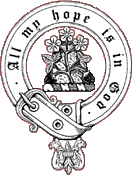 |
Frasers on the Net Clan Fraser Discussion Area Clan Fraser Contacts |
There are many stories about the origin of the name Fraser. According to Clan Fraser: A history celebrating over 800 years of the Family in Scotland [1997] by Flora Marjory Fraser, 20th Lady Saltoun: The truth of these stories is unknown but it is generally believed that the name Fraser traces its origins to the French provinces of Anjou and Normandy. The French word strawberry is fraise and growers are called fraisiers. The Fraser arms are silver strawberry flowers on a field of blue. Only the Chief is entitled to use these arms plain and undifferenced.
 The Frasers
first appear in Scotland around 1160 when Simon Fraser made a
gift of a church at Keith in East Lothian, to the monks at Kelso
Abbey. The Frasers moved into Tweeddale in the 12th and 13th
centuries and from there into the counties of Stirling, Angus,
Inverness and Aberdeen.
The Frasers
first appear in Scotland around 1160 when Simon Fraser made a
gift of a church at Keith in East Lothian, to the monks at Kelso
Abbey. The Frasers moved into Tweeddale in the 12th and 13th
centuries and from there into the counties of Stirling, Angus,
Inverness and Aberdeen.
About five generations later, Sir Simon Fraser [the Patriot] was captured fighting for Robert the Bruce, and executed with great cruelty by Edward I in 1306. The patriot’s line ended with two co-heiresses. Sir Andrew Fraser of Touch-Fraser, cousin of the patriot, was the father of Sir Alexander Fraser of Cowie [ancestor of the Frasers of Philorth], Sir Simon Fraser [ancestor of the Frasers of Lovat], Sir Andrew Fraser and Sir James Fraser of Frendraught.
Frasers of Philorth [Lords Saltoun]

The senior line is descended from Sir Alexander Fraser, who
married Robert the Bruce's widowed sister, Lady Mary, who had
been imprisoned in a cage by Edward I.
His grandson, Sir Alexander Fraser of Cowie, acquired the Castle (now Cairnbulg) and lands of Philorth by marriage with Lady Joanna, younger daughter and co-heiress of the Earl of Ross in 1375. Eight generations later, Sir Alexander Fraser, 8th laird of Philorth, founded Fraser's Burgh by royal charters obtained in 1592, and also built Fraserburgh Castle, now Kinnaird Head Lighthouse Museum. His son, the 9th laird, married the heiress of the Abernethies, Lords Saltoun, and in 1669 their son, Alexander Fraser, became the 10th Lord Saltoun. The present Chief of the Name of Fraser is Flora Marjory Fraser, 20th Lady Saltoun, who is an active member of the House of Lords. The family seat is Fraserburgh, Aberdeenshire.
Frasers of Lovat [Lords Lovat]
The Frasers of Lovat descend from Sir Simon Fraser [brother of
Sir Alexander Fraser, the Chamberlain], who married Lady Margaret
Sinclair, daughter of the Earl of Caithness. Documents, dated
12th September 1367, connect a Fraser with the lands of Lovat and
the Aird. Among the lands acquired by the Lovat Frasers, the
prominent ones were in Stratherrick, which was very dear to the hearts
of the Lovat chiefs, the church lands of Beauly Priory in
Inverness-shire, part of the south shore of Beauly Firth, and the
whole of Strathfarrar. Beauly was founded in about 1320 by John
Bisset, who also built Lovat Castle. About 1460 Hugh Fraser, 6th
laird of Lovat, became the 1st Lord Lovat. The 11th Lord Lovat
was beheaded on Tower Hill in London in 1747, following which the
Lovat title was attained and the estates were forfeited to the
Crown.
dear to the hearts
of the Lovat chiefs, the church lands of Beauly Priory in
Inverness-shire, part of the south shore of Beauly Firth, and the
whole of Strathfarrar. Beauly was founded in about 1320 by John
Bisset, who also built Lovat Castle. About 1460 Hugh Fraser, 6th
laird of Lovat, became the 1st Lord Lovat. The 11th Lord Lovat
was beheaded on Tower Hill in London in 1747, following which the
Lovat title was attained and the estates were forfeited to the
Crown.
The estates eventually passed to the nearest collateral heir-male, Thomas Alexander Fraser, 10th laird of Strichen, Aberdeenshire, who in 1837 was created Baron Lovat in the Peerage of the U.K., and the attainder of the Scottish title was reversed in 1857, when he became 14th Lord Lovat. With the death of the 17th Lord Lovat in 1995, aged 83, his eldest son and his youngest son having died the previous year, his grandson, Simon Fraser, born in 1977, became the 18th Lord Lovat and 25th MacShimi, the Chief of Clan Fraser of Lovat. Castle Dounie was home of the chiefs of Lovat from 1511 until it was burned following Culloden. The current Beaufort Castle, built in the 1880s, was sold in 1995. The Lovat family seat is Beauly, Inverness-shire.
Frasers of Muchalls [Lords Fraser]
In 1366 Thomas Fraser, a descendant of Sir Alexander Fraser of
Cornton [brother of Sir Richard Fraser of Touch-Fraser],
exchanged the lands in Petyndreich, Stirlingshire for those of
Kinmundy, Aberdeenshire. His grandson Thomas exchanged the estate
of Cornton for Stonywood and Muchalls in Aberdeenshire. His
descendant, Andrew Fraser, who was created Lord Fraser in 1633,
completed Castle Fraser in 1636. Following the premature death in
1716 of Charles, 4th Lord Fraser, the estates passed to the heirs
of his wife’s first marriage, the Frasers of Inverallochy,
later assuming the name of Mackenzie-Fraser. Castle Fraser was
sold at auction to the 1st Viscount Cowdray in 1921 and given to
the National Trust for Scotland in 1976.
Information on these pages is courtesy of Clan Fraser Society of Canada. For more information on the clan or the society, please visit their page.






